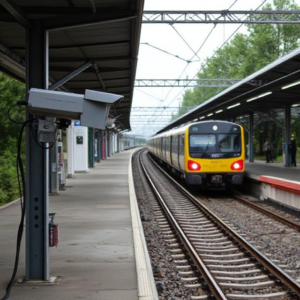What Are Advanced Railway Simulation Systems?
Advanced railway simulation systems are like virtual “train systems” created using computers to replicate how real trains, tracks, and stations work. These systems are used to test, plan, and improve railway operations without actually running any trains on real tracks. It’s like using a video game to practice train operations, but with more accuracy and purpose!

How Do They Work?
These systems use computer programs to simulate (or mimic) everything that happens in a real railway system, like how trains move, interact with each other, or even how they react to things like track conditions and weather.
The simulation uses real-world data, such as:
- Train schedules and routes
- Train speeds and braking systems
- The layout of tracks, stations, and signals
- Weather conditions
- Passenger flows
These simulations can create virtual versions of:
- Train movement: How a train moves along tracks, stops at stations, accelerates, and brakes.
- Track and signal systems: How signals change and how trains follow them.
- Station operations: How passengers board and disembark, and how the station infrastructure works.
Types of Simulations
- Train Operation Simulations
- What it is: These simulate how a train behaves on the track—things like acceleration, speed, and stopping. The simulation can show how different factors like track conditions or weather affect the train’s movement.
- How it works: You can test out different scenarios (like a signal failure, heavy rain, or a track obstruction) to see how the train and its operators respond.
- Why it’s important: This helps improve safety by making sure the train performs well in different situations before those situations happen in real life.
- Rail Network Simulation
- What it is: This type of simulation looks at the whole railway system—how trains interact, how schedules are managed, and how traffic is controlled.
- How it works: The system tests how trains move between different stations, how they are scheduled, and how signals and switches are managed in a busy rail network.
- Why it’s important: It helps to find the most efficient and safe ways to schedule trains, avoid delays, and prevent collisions or accidents.
- Passenger Flow Simulation
- What it is: This simulation focuses on how passengers move around a station or train. It looks at things like how many people are waiting, where they’re standing, and how long it takes them to board or disembark.
- How it works: It creates scenarios like rush hours or unexpected delays and shows how passengers behave in these situations.
- Why it’s important: This helps to design better stations, improve the flow of passengers, and reduce crowding or delays, making the travel experience smoother.
- Train Control and Signaling Simulation
- What it is: This type of simulation mimics the communication between trains and signals. It helps test how signals control train movement and how trains respond to different signals.
- How it works: It checks how the signaling system works under different conditions, such as when there’s a malfunction or during peak traffic hours.
- Why it’s important: Ensures the signaling systems are safe and efficient, and helps prevent accidents or mishaps caused by signal errors.
Benefits of Advanced Railway Simulation Systems
- Safety Testing
- Before new trains or systems are put into operation, they can be tested in a simulation to see if they’ll work safely under different conditions. This helps prevent accidents and costly mistakes.
- Optimizing Train Schedules
- The simulation helps planners test different schedules to find the most efficient and safest ways for trains to move. This ensures that there are fewer delays, trains run on time, and there’s less chance of trains overcrowding.
- Training Operators
- Train drivers and station staff can use simulation systems to practice different scenarios, like emergency situations, without the risks of doing it on a real train. This helps them become more skilled and prepared.
- Designing Infrastructure
- Planners can use simulations to design stations, tracks, and even signaling systems, testing them virtually before any construction takes place. This helps create better designs that improve efficiency and safety.
- Cost Savings
- By testing different scenarios in a simulation, railway companies can avoid expensive trial-and-error mistakes. It saves money by improving efficiency and identifying issues early on before they become costly problems.
- Predicting Problems and Solutions
- The simulation allows railway operators to predict problems (like delays, accidents, or maintenance issues) and try out solutions in a virtual environment. It helps to find the best ways to handle them before they happen in real life.
Examples of Advanced Railway Simulation Systems
- Train Movement Simulators: These systems mimic how a train moves along tracks, allowing engineers to test how the train will behave under different conditions (like sharp curves or steep inclines).
- Railway Network Simulators: Used by large railway networks (like in Europe or Japan), these systems simulate the entire rail network to test scheduling, traffic management, and how trains interact with one another across multiple routes.
- Passenger Simulation Systems: These systems are used to plan for things like crowded stations during rush hour or in case of emergencies, to figure out the best ways to manage large crowds.
Conclusion:
Advanced Railway Simulation Systems are like virtual testing grounds where railway operators, engineers, and planners can experiment, test ideas, and plan improvements without the risks of real-life trials. These systems help improve safety, efficiency, and passenger experience, and they allow for smarter planning and decision-making in the railway industry.
Keywords: Railway Data Analytics, Railway











